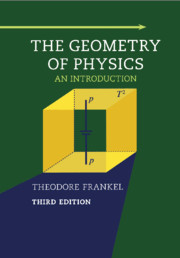Book contents
- Frontmatter
- Contents
- Preface to the Third Edition
- Preface to the Second Edition
- Preface to the Revised Printing
- Preface to the First Edition
- Overview. An Informal Overview of Cartan's Exterior Differential Forms, Illustrated with an Application to Cauchy's Stress Tensor
- I Manifolds, Tensors, and Exterior Forms
- II Geometry and Topology
- 7 ℝ3 and Minkowski Space
- 8 The Geometry of Surfaces in ℝ3
- 9 Covariant Differentiation and Curvature
- 10 Geodesics
- 11 Relativity, Tensors, and Curvature
- 12 Curvature and Topology: Synge's Theorem
- 13 Betti Numbers and De Rham's Theorem
- 14 Harmonic Forms
- III Lie Groups, Bundles, and Chern Forms
- Appendix A Forms in Continuum Mechanics
- Appendix B Harmonic Chains and Kirchhoff's Circuit Laws
- Appendix C Symmetries, Quarks, and Meson Masses
- Appendix D Representations and Hyperelastic Bodies
- Appendix E Orbits and Morse–Bott Theory in Compact Lie Groups
- References
- Index
11 - Relativity, Tensors, and Curvature
from II - Geometry and Topology
Published online by Cambridge University Press: 05 June 2012
- Frontmatter
- Contents
- Preface to the Third Edition
- Preface to the Second Edition
- Preface to the Revised Printing
- Preface to the First Edition
- Overview. An Informal Overview of Cartan's Exterior Differential Forms, Illustrated with an Application to Cauchy's Stress Tensor
- I Manifolds, Tensors, and Exterior Forms
- II Geometry and Topology
- 7 ℝ3 and Minkowski Space
- 8 The Geometry of Surfaces in ℝ3
- 9 Covariant Differentiation and Curvature
- 10 Geodesics
- 11 Relativity, Tensors, and Curvature
- 12 Curvature and Topology: Synge's Theorem
- 13 Betti Numbers and De Rham's Theorem
- 14 Harmonic Forms
- III Lie Groups, Bundles, and Chern Forms
- Appendix A Forms in Continuum Mechanics
- Appendix B Harmonic Chains and Kirchhoff's Circuit Laws
- Appendix C Symmetries, Quarks, and Meson Masses
- Appendix D Representations and Hyperelastic Bodies
- Appendix E Orbits and Morse–Bott Theory in Compact Lie Groups
- References
- Index
Summary
Heuristics of Einstein's Theory
What does g00 have to do with gravitation?
The Metric Potentials
Einstein's general theory of relativity is primarily a replacement for Newtonian gravitation and a generalization of special relativity. It cannot be “derived”; we can only speculate, with Einstein, by heuristic reasoning, how such a generalization might proceed. His path was very thorny, and we shall not hesitate to replace some of his reasoning, with hindsight, by more geometrical methods.
Einstein assumed that the actual space–time universe is some pseudo-Riemannian manifold M4 and is thus a generalization of Minkowski space. In any local coordinates x0 = t, x1, x2, x3 the metric is of the form
where Greek indices run from 1 to 3, and g00 must be negative. We may assume that we have chosen units in which the speed of light is unity when time is measured by the local atomic clocks (rather than the coordinate time t of the local coordinate system). Thus an “orthonormal” frame has 〈e0, e0〉 = -1, 〈e0, eβ〉 = 0, and 〈eα, eβ〉 = δαβ.
Warning: Many other books use the negative of this metric instead.
To get started, Einstein considered the following situation. We imagine that we have massive objects, such as stars, that are responsible in some way for the preceding metric, and we also have a very small test body, a planet, that is so small that it doesn't appreciably affect the metric.
- Type
- Chapter
- Information
- The Geometry of PhysicsAn Introduction, pp. 291 - 322Publisher: Cambridge University PressPrint publication year: 2011

